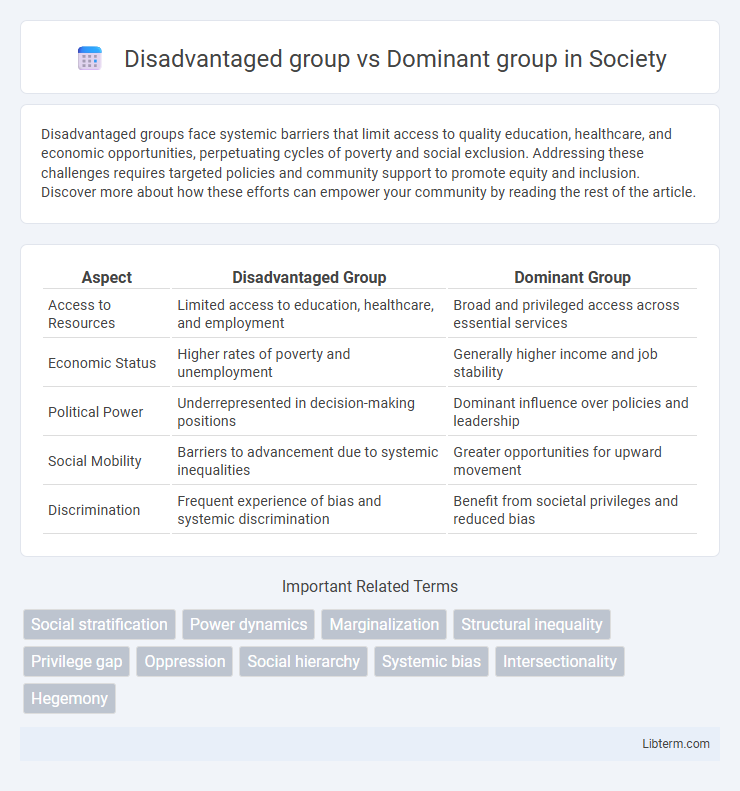Disadvantaged groups face systemic barriers that limit access to quality education, healthcare, and economic opportunities, perpetuating cycles of poverty and social exclusion. Addressing these challenges requires targeted policies and community support to promote equity and inclusion. Discover more about how these efforts can empower your community by reading the rest of the article.
Table of Comparison
| Aspect | Disadvantaged Group | Dominant Group |
|---|---|---|
| Access to Resources | Limited access to education, healthcare, and employment | Broad and privileged access across essential services |
| Economic Status | Higher rates of poverty and unemployment | Generally higher income and job stability |
| Political Power | Underrepresented in decision-making positions | Dominant influence over policies and leadership |
| Social Mobility | Barriers to advancement due to systemic inequalities | Greater opportunities for upward movement |
| Discrimination | Frequent experience of bias and systemic discrimination | Benefit from societal privileges and reduced bias |
Introduction to Disadvantaged and Dominant Groups
Disadvantaged groups often face systemic barriers in access to resources, opportunities, and social recognition, impairing their economic, educational, and political progress. In contrast, dominant groups typically hold structural power and influence, shaping societal norms, policies, and institutions to maintain their advantages. Understanding the social dynamics between these groups is essential for addressing inequality and promoting social justice.
Defining Key Terms: Disadvantaged vs. Dominant
Disadvantaged groups experience systemic inequalities limiting access to resources, opportunities, and social power, often resulting from historical marginalization and discrimination. Dominant groups hold disproportionate power, influence, and privilege in social, economic, and political spheres, shaping societal norms and policies to maintain their status. Understanding these terms is crucial for analyzing social dynamics and addressing equity and inclusion challenges.
Historical Context of Group Inequality
Historical context reveals that disadvantaged groups have faced systemic barriers such as segregation, disenfranchisement, and unequal access to resources, reinforcing social and economic disparities. Dominant groups have often maintained power through institutional policies, cultural norms, and economic control, perpetuating inequality across generations. The legacy of colonialism, slavery, and discriminatory laws continues to shape the socio-political landscape, affecting opportunities and representation for marginalized communities.
Socioeconomic Disparities and Their Roots
Disadvantaged groups often face socioeconomic disparities rooted in historical inequities, limited access to quality education, and systemic employment barriers. In contrast, dominant groups typically benefit from accumulated wealth, social capital, and policy frameworks that reinforce their economic advantages. These entrenched inequalities perpetuate cycles of poverty and limit upward mobility for marginalized populations across generations.
Power Dynamics and Social Structures
Power dynamics between disadvantaged and dominant groups shape social structures through unequal access to resources, opportunities, and decision-making authority. Dominant groups maintain their status by controlling institutional norms and cultural narratives, reinforcing systemic inequalities that marginalize disadvantaged populations. Understanding these interactions highlights how social hierarchies perpetuate disparities in wealth, education, and political influence across various societies.
Impacts on Access to Resources and Opportunities
Disadvantaged groups experience systemic barriers that limit their access to essential resources such as quality education, healthcare, and economic opportunities, perpetuating cycles of poverty and social exclusion. Dominant groups typically control key institutions and networks, enabling preferential access to wealth, political power, and social mobility. This uneven distribution reinforces social stratification and hinders equitable development across communities.
Psychological Effects of Group Status
Disadvantaged groups often experience increased levels of stress, reduced self-esteem, and heightened vulnerability to anxiety and depression due to systemic marginalization and social exclusion. In contrast, dominant groups tend to exhibit greater psychological resilience and higher self-assurance, benefiting from societal privileges and access to resources. The psychological effects of group status are closely linked to identity threat, internalized stereotypes, and the social support available within each group.
Representation in Media and Public Discourse
Disadvantaged groups often face underrepresentation and stereotyping in media and public discourse, which perpetuates social inequalities and limits their visibility in mainstream narratives. Dominant groups control most media platforms and public conversations, enabling them to shape societal norms, reinforce power structures, and marginalize alternative perspectives. Increasing diverse representation is essential for equitable social influence and authentic cultural inclusion in media and public spheres.
Pathways to Social Inclusion and Equity
Disadvantaged groups face systemic barriers in accessing resources, opportunities, and representation, which necessitates targeted pathways to social inclusion and equity such as inclusive policies, affirmative action, and equitable resource distribution. Dominant groups hold structural power that can be leveraged to dismantle inequalities and foster environments where marginalized voices influence decision-making processes. Strategies focusing on education, economic empowerment, and community engagement create sustainable pathways that promote social justice and reduce disparities between disadvantaged and dominant groups.
Conclusion: Bridging the Group Divide
Effective strategies to bridge the divide between disadvantaged and dominant groups emphasize equitable access to resources, inclusive representation, and sustained dialogue to dismantle systemic barriers. Prioritizing social justice initiatives and institutional reforms fosters mutual understanding and empowers marginalized communities, promoting long-term societal cohesion. Collaborative efforts grounded in empathy and equity are essential for achieving lasting integration and reducing disparities.
Disadvantaged group Infographic

 libterm.com
libterm.com